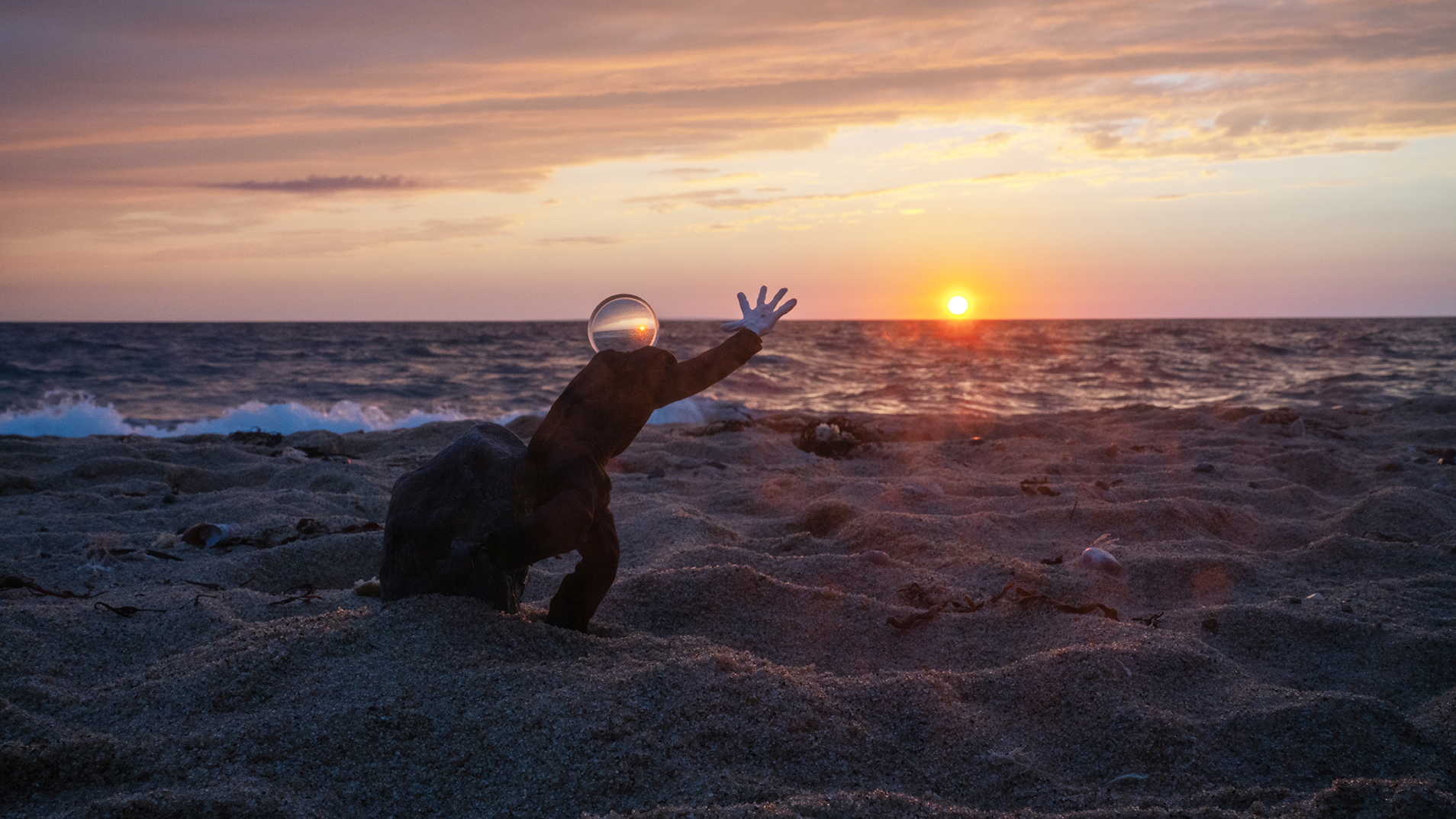SARA STERN
sand plays itself
Opening Reception: 6-8 PM September 6, 2024
Closing Reception: 6-8 PM September 29, 2024
September 6 – September 29, 2024
Open Friday-Sunday 12-6 PM and by appointment
Opening Reception: 6-8 PM September 6, 2024
Closing Reception: 6-8 PM September 29, 2024
September 6 – September 29, 2024
Open Friday-Sunday 12-6 PM and by appointment
 Sara Stern, still from Mirror Ball, 2022-ongoing, single-channel video with stop motion animation, live action, color/sound, duration variable.
Sara Stern, still from Mirror Ball, 2022-ongoing, single-channel video with stop motion animation, live action, color/sound, duration variable. On the spit of sand known as Provincetown, in dunes endlessly remade by wind, Sara Stern filmed a series of site-responsive vignettes. sand plays itself features two moving image installations built from her plein-air improvisations: Mirror Ball (2022–ongoing), which follows a cast of puppets, some of whom play optical tricks, as they move through the landscape, and Beach Effect (2024), in which sandy minor characters from Mirror Ball star in a beachside romp. Beach Effect is by and large a live-action puppetry video, set to tidal tempos and music by Katie Austra Stelmanis. Mirror Ball moves between live action and stop motion animation, a technique which—as evinced by the fast-changing sky and sea—condenses hours into seconds, evoking thickened time scales. How do you look at a place and see all the time in it? The dunes were forests, once, and debris at a glacier’s snout long before that. Today, the terrain flickers, mirage-like, between desert-style stretches, boggy patches, and sections of scrub and pitch pine—the memory of the forest peeking through. Stern calls this “landscape drag”: the way the dunes, which have been so many things, can perform an array of cinematic genres, with a wink.
Provincetown is steeped in queer histories that are intertwined with the town’s legacies of artist communities. Watching these videos, in which a sand-creature caresses the surrounding sediment from whence it came, or two disco-ball-headed figures twine themselves around a shrub that suddenly appears tree-sized, I can’t help but feel that the land itself is acting queerly. The notion that the protean sandscape—grounds of past, present, and future cruising—might have a hand in unsettling norms around sexuality, pleasure, and kinship is playfully literalized in the sand-on-sand liaisons of Beach Effect. The work takes its title from a term that Roland Barthes, writing in 1977, employed to convey a soporific, sensual, and distinctly beachside sensibility, described by scholar Hannah Freed-Thall as “an experiment with idleness and sensory drift…the transformation of his being into a supersensible surface for contact with the elements.”
The dunes are a setting, but when a hardy blade of grass traces its own circumference in the sand under the wind’s direction, or a rising tide gradually floods the screen, I’m reminded that they are also a character or event. At the same time, the site is a cultural substrate on whose rich artistic histories Mirror Ball, in particular, draws. Improvisatory scenes in which characters perform with and for one another—dancing, pausing, posing—on a stage of sand, scrub, and sea recall the intimate performative photographs of PaJaMa, the romantic-artistic tangle of Paul Cadmus, Jared French, and Margaret Hoening French, for whom the surreal landscapes of Provincetown (and other beach retreats like Fire Island) served as backdrop and prompt. Meanwhile, perceptual play suggests the enduring presence of the late lesbian experimental filmmaker Barbara Hammer, whose creations are suffused with feeling and touch. During a monthlong artist residency in 1998, Hammer lived in a Provincetown dune shack. She recorded her experience—including optical experiments in the environment—on 16mm film: a window covered with lighting gels, the meniscus in a water glass held over a horizon line, a zone of sand modulated with rakes and color filters. These moments reverberate in Mirror Ball, manifesting as lighting gels that act as rambunctious circus entertainers; the titular disco balls, which throw the landscape back on itself in moving pieces; and scenes in which lens-headed characters watch the stop-motion sun sink below the horizon, the lenses inverting the sunset. For a moment—a blink, really—Hammer appears on horseback, her spectral image reflected in a quivering mirror in the sand. Maybe there are spirits in this place, where time feels thick and non-linear, and pleasure seems distributed and spacious, all knit into the fabric of this shifting ground. Or maybe it’s just a trick of the eye.
–Cassie Packard
Sara Stern is an interdisciplinary artist based in New York City. Her recent projects prod varied histories of landscape and urban development with speculative fiction. She works between and across multimedia performance, moving image installation, sculpture, architectural intervention, and animation. Stern has exhibited and screened her work in the US and internationally, at venues including SculptureCenter (Long Island City, NY), Anthology Film Archives (New York, NY), the Museum of the Moving Image (New York, NY), The Jewish Museum (New York, NY), and the Institute of Contemporary Arts Singapore (Singapore). Stern had a solo show at Ortega y Gasset Projects (Brooklyn, NY) in January 2024 which explored glass as a doppelganger material. sand plays itself is Stern's first solo exhibition at Essex Flowers.---
Thank you to the Stephen and Palmina Pace Fellowship and the Fine Arts Work Center in Provincetown, MA.









Installation photography by Gustavo Murillo